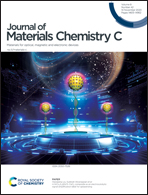Photo-tunable organic resistive random access memory based on PVP/N-doped carbon dot nanocomposites for encrypted image storage†
Abstract
Optoelectronic resistive switching (RS) devices are attracting attention due to their promising potential in optical communication technology. In this study, a photo-tunable organic memory device based on poly(4-vinylphenol) (PVP) and N-doped carbon quantum dot nanocomposites is presented. After UV light irradiation, the set voltage of the device can be gradually reduced by adjusting the irradiation time. This memory device presents excellent memory performance after large-angle bending or repetitive bending tests. More importantly, the controlled switching voltage characteristic enabled the realization of encrypted image storage. Raman spectra evidence that a local conductive sp2-hybridized carbon region was generated through UV light reduction, which can effectively enhance the internal electrical field and shorten the tunneling distance between the carbon dots, thus decreasing the set voltage. Our work provides a new approach towards the development of photo-tunable organic memory for future wearable optoelectronic neuromorphic computing systems.



 Please wait while we load your content...
Please wait while we load your content...